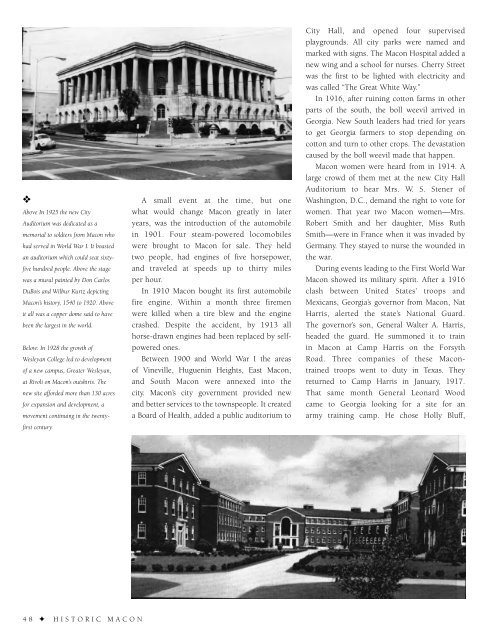Historic Macon
An illustrated history of the city of Macon, paired with the histories of companies, families and organizations that make the region great.
An illustrated history of the city of Macon, paired with the histories of companies, families and organizations that make the region great.
You also want an ePaper? Increase the reach of your titles
YUMPU automatically turns print PDFs into web optimized ePapers that Google loves.
❖<br />
Above In 1925 the new City<br />
Auditorium was dedicated as a<br />
memorial to soldiers from <strong>Macon</strong> who<br />
had served in World War I. It boasted<br />
an auditorium which could seat sixtyfive<br />
hundred people. Above the stage<br />
was a mural painted by Don Carlos<br />
DuBois and Wilbur Kurtz depicting<br />
<strong>Macon</strong>’s history, 1540 to 1920. Above<br />
it all was a copper dome said to have<br />
been the largest in the world.<br />
Below: In 1928 the growth of<br />
Wesleyan College led to development<br />
of a new campus, Greater Wesleyan,<br />
at Rivoli on <strong>Macon</strong>’s outskirts. The<br />
new site afforded more than 130 acres<br />
for expansion and development, a<br />
movement continuing in the twentyfirst<br />
century.<br />
A small event at the time, but one<br />
what would change <strong>Macon</strong> greatly in later<br />
years, was the introduction of the automobile<br />
in 1901. Four steam-powered locomobiles<br />
were brought to <strong>Macon</strong> for sale. They held<br />
two people, had engines of five horsepower,<br />
and traveled at speeds up to thirty miles<br />
per hour.<br />
In 1910 <strong>Macon</strong> bought its first automobile<br />
fire engine. Within a month three firemen<br />
were killed when a tire blew and the engine<br />
crashed. Despite the accident, by 1913 all<br />
horse-drawn engines had been replaced by selfpowered<br />
ones.<br />
Between 1900 and World War I the areas<br />
of Vineville, Huguenin Heights, East <strong>Macon</strong>,<br />
and South <strong>Macon</strong> were annexed into the<br />
city. <strong>Macon</strong>’s city government provided new<br />
and better services to the townspeople. It created<br />
a Board of Health, added a public auditorium to<br />
City Hall, and opened four supervised<br />
playgrounds. All city parks were named and<br />
marked with signs. The <strong>Macon</strong> Hospital added a<br />
new wing and a school for nurses. Cherry Street<br />
was the first to be lighted with electricity and<br />
was called “The Great White Way.”<br />
In 1916, after ruining cotton farms in other<br />
parts of the south, the boll weevil arrived in<br />
Georgia. New South leaders had tried for years<br />
to get Georgia farmers to stop depending on<br />
cotton and turn to other crops. The devastation<br />
caused by the boll weevil made that happen.<br />
<strong>Macon</strong> women were heard from in 1914. A<br />
large crowd of them met at the new City Hall<br />
Auditorium to hear Mrs. W. S. Stener of<br />
Washington, D.C., demand the right to vote for<br />
women. That year two <strong>Macon</strong> women—Mrs.<br />
Robert Smith and her daughter, Miss Ruth<br />
Smith—were in France when it was invaded by<br />
Germany. They stayed to nurse the wounded in<br />
the war.<br />
During events leading to the First World War<br />
<strong>Macon</strong> showed its military spirit. After a 1916<br />
clash between United States’ troops and<br />
Mexicans, Georgia’s governor from <strong>Macon</strong>, Nat<br />
Harris, alerted the state’s National Guard.<br />
The governor’s son, General Walter A. Harris,<br />
headed the guard. He summoned it to train<br />
in <strong>Macon</strong> at Camp Harris on the Forsyth<br />
Road. Three companies of these <strong>Macon</strong>trained<br />
troops went to duty in Texas. They<br />
returned to Camp Harris in January, 1917.<br />
That same month General Leonard Wood<br />
came to Georgia looking for a site for an<br />
army training camp. He chose Holly Bluff,<br />
48 ✦ HISTORIC MACON
















